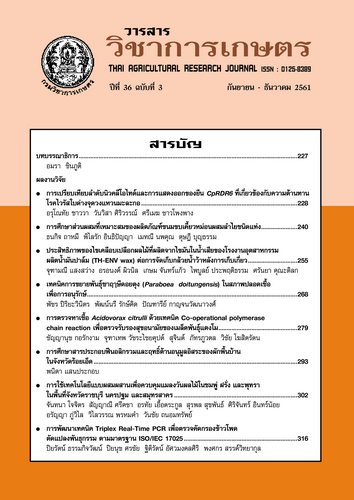ประสิทธิภาพของไขเคลือบเปลือกผลไม้ที่ผลิตจากไขมันในน้ำเสียของโรงงานอุตสาหกรรม ผลิตน้ำมันปาล์ม (TH-ENV wax) ต่อการจัดเก็บกล้วยน้ำว้าหลังการเก็บเกี่ยว
DOI:
https://doi.org/10.14456/thaidoa-agres.2018.20คำสำคัญ:
ปาล์ม, เสียว, ไขมัน, ไขเคลือบเปลือกผลไม้, กล้วยบทคัดย่อ
การวิจัยนี้มีวัตถุประสงค์เพื่อศึกษาลักษณะโมเลกุลของ grease ที่เกิดขึ้นในน้ำเสียของโรงงานอุตสาหกรรมผลิตน้ำมันปาล์ม เพื่อพัฒนาเป็นสูตรไขเคลือบเปลือกผลไม้ (TH-ENV wax)โดยใช้ไขมันที่ทำความสะอาดแล้วเป็นวัตถุดิบและทดสอบประสิทธิภาพของ TH-ENV waxในการรักษาคุณภาพของกล้วยน้ำว้าหลังการเก็บเกี่ยวโดยนำตัวอย่างน้ำเสียจากถังดักไขมันของระบบำบัดน้ำเสียโรงงานอุตสาหกรรมผลิตน้ำมันปาล์มปริมาณ 20 ล. แล้วนำตัวอย่าง grease ในน้ำเสียมาศึกษาลักษณะโมเลกุล พบว่า ส่วนที่เป็นไขมัน(base oil) จะอยู่ล้อมรอบแกนกลางที่เป็นโลหะขนาดโมเลกุลเท่ากับ 0.8x1.1 ตารางไมโครเมตรทำการแยกไขมันออกจาก grease โดยนำน้ำเสียมาผสมกับกรดอะซิติก 5% ในอัตราส่วน น้ำเสีย:กรดอะซิติก เท่ากับ 3:1 แล้วนำมาหมุนเหวี่ยงที่ความเร็ว 3,000 รอบ/นาที เป็นเวลา 15 นาทีส่วนผสมที่ถูกหมุนเหวี่ยงจะแยกตัวออกเป็น 3 ชั้นคือ ชั้นไขมัน (fat layer) ชั้นของเหลว (liquidlayer) และชั้นตะกอน (sludge layer) จากนั้นเก็บส่วนไขมันชั้นบนสุดไปล้างทำความสะอาดโดยผสมกับน้ำเปล่าในอัตราส่วน ไขมัน : น้ำ เท่ากับ 1:1 และทำ การหมุนเหวี่ยง 3 ครั้ง ใช้ความเร็ว 3,000 รอบ/นาที เป็นเวลา 15 นาที ได้ไขมันคิดเป็น 4.3 มล./น้ำเสีย 1 ล. ผลการวิเคราะห์การปนเปื้อนโลหะด้วยเทคนิค AAS พบว่าปริมาณโลหะหนักที่ปนเปื้อน มีค่าไม่เกินค่ามาตรฐานความปลอดภัย จึงนำไขมันที่ผ่านกระบวนการทำความสะอาดแล้ว มาใช้เป็นวัตถุดิบในการผลิต TH-ENV wax ซึ่งเป็นไขเคลือบประเภทbilayer composites (lipid/polysaccharide)ประกอบด้วยไขมัน 30% สารสกัดใบสาบเสือ 5%แป้งท้าวยายม่อม (3 ส่วนผสมน้ำ 1 ส่วน) 10%ไคโตซาน 50% น้ำ 50% โดยปริมาตร และเติมTriton X-100 จำนวน 10 หยดต่อปริมาตร TH-ENV wax 200 มล. จากนั้นนำ TH-ENV waxที่พัฒนาได้มาทดสอบประสิทธิภาพในการเก็บรักษากล้วยน้ำว้าหลังการเก็บเกี่ยว โดยนำ TH-ENV wax มาเจือจางด้วยน้ำในอัตราส่วน 1:1 เคลือบผิวเปลือกกล้วยด้วยวิธีการจุ่ม 2 ครั้ง และจัดเก็บไว้ในอุณหภูมิห้อง พบว่า กล้วยที่เคลือบด้วย TH-ENV wax มีการสูญเสียน้ำหนักน้อยกว่ากล้วยที่ไม่ผ่านการเคลือบอย่างมีนัยสำคัญที่ระดับ 0.01 เมื่อจัดเก็บไว้ 1 วัน และมีการเพิ่มขึ้นของค่าความหวานน้อยกว่ากล้วยที่ไม่ผ่านการเคลือบอย่างมีนัยสำคัญ เมื่อจัดเก็บไว้ 5 วัน กล้วยที่เคลือบด้วย TH-ENV wax เริ่มเสื่อมสภาพโดยการเปลี่ยนแปลงสีเปลือก ลักษณะผิวเปลือกและความนิ่มของเนื้อผลเพิ่มขึ้น เมื่อเก็บไว้เป็นเวลา 5 วัน ขณะที่กล้วยที่ไม่ได้เคลือบด้วยTH-ENV wax เริ่มเสื่อมสภาพในวันที่ 3
ดาวน์โหลด
เผยแพร่แล้ว
รูปแบบการอ้างอิง
ฉบับ
ประเภทบทความ
สัญญาอนุญาต

อนุญาตภายใต้เงื่อนไข Creative Commons Attribution-NonCommercial-NoDerivatives 4.0 International License.
วารสารวิชาการเกษตร



